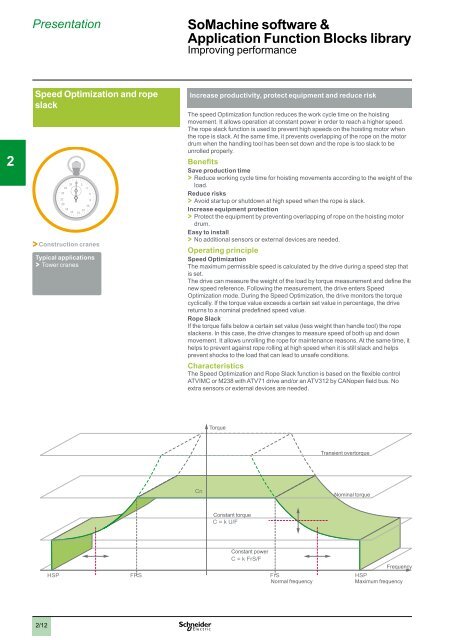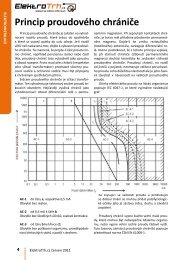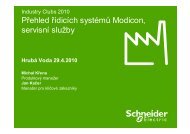2 - Schneider Electric CZ, s.r.o.
2 - Schneider Electric CZ, s.r.o.
2 - Schneider Electric CZ, s.r.o.
You also want an ePaper? Increase the reach of your titles
YUMPU automatically turns print PDFs into web optimized ePapers that Google loves.
Presentation<br />
SoMachine software &<br />
Application Function Blocks library<br />
Improving performance<br />
1<br />
2<br />
3<br />
4<br />
5<br />
6<br />
Speed Optimization and rope<br />
slack<br />
> > Construction cranes<br />
Typical applications<br />
> > Tower cranes<br />
Increase productivity, protect equipment and reduce risk<br />
The speed Optimization function reduces the work cycle time on the hoisting<br />
movement. It allows operation at constant power in order to reach a higher speed.<br />
The rope slack function is used to prevent high speeds on the hoisting motor when<br />
the rope is slack. At the same time, it prevents overlapping of the rope on the motor<br />
drum when the handling tool has been set down and the rope is too slack to be<br />
unrolled properly.<br />
Benefits<br />
Save production time<br />
> > Reduce working cycle time for hoisting movements according to the weight of the<br />
load.<br />
Reduce risks<br />
> > Avoid startup or shutdown at high speed when the rope is slack.<br />
Increase equipment protection<br />
> > Protect the equipment by preventing overlapping of rope on the hoisting motor<br />
drum.<br />
Easy to install<br />
> > No additional sensors or external devices are needed.<br />
Operating principle<br />
Speed Optimization<br />
The maximum permissible speed is calculated by the drive during a speed step that<br />
is set.<br />
The drive can measure the weight of the load by torque measurement and define the<br />
new speed reference. Following the measurement, the drive enters Speed<br />
Optimization mode. During the Speed Optimization, the drive monitors the torque<br />
cyclically. If the torque value exceeds a certain set value in percentage, the drive<br />
returns to a nominal predefined speed value.<br />
Rope Slack<br />
If the torque falls below a certain set value (less weight than handle tool) the rope<br />
slackens. In this case, the drive changes to measure speed of both up and down<br />
movement. It allows unrolling the rope for maintenance reasons. At the same time, it<br />
helps to prevent against rope rolling at high speed when it is still slack and helps<br />
prevent shocks to the load that can lead to unsafe conditions.<br />
Characteristics<br />
The Speed Optimization and Rope Slack function is based on the flexible control<br />
ATVIMC or M238 with ATV71 drive and/or an ATV312 by CANopen field bus. No<br />
extra sensors or external devices are needed.<br />
7<br />
Torque<br />
8<br />
Transient overtorque<br />
Cn<br />
Nominal torque<br />
9<br />
Constant torque<br />
C = k U/F<br />
10<br />
Constant power<br />
C = k FrS/F<br />
Frequency<br />
HSP FRS FrS HSP<br />
Normal frequency<br />
Maximum frequency<br />
2/12
















